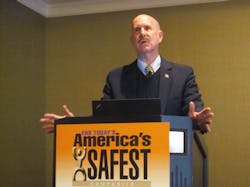Safety and sustainability seem like a natural fit. After all, can a company really be considered "sustainable" if it has a poor record in occupational safety and health?
Along the same lines, should a new building be eligible for LEED certification if workers were killed or seriously injured during its construction?
Yet while sustainability has earned prominent placement in many annual reports, safety is on the outside looking in at the corporate social responsibility movement. Meanwhile, environmental watchdog groups dominate the sustainability conversation.
How did this happen?
During a thought-provoking session at the 2013 America's Safest Companies Conference in Atlanta, panelists discussed some of the reasons that safety got left behind – and how the profession can secure a more prominent seat at the table.
"The first step in any problem is to recognize that you have a problem," NIOSH Director John Howard said.
"The problem is that all of us have not put safety and health in the sustainability conversation. We didn't go to environmental sustainability conferences. We didn't say, 'Look, you forgot something.'"
Over the years, the profession hasn't communicated the linkages between safety and sustainability, nor has it effectively conveyed the real value of safety to overall business operations, asserted Michael Vigezzi, General Electric Co.'s global manager for VPP and safety programs.
"Safety and health helps to drive environmental sustainability," Vigezzi asserted. "So when we talk about waste reduction, about water reduction, there's a safety impact to it. We're not able to make the product if we can't make it safely. We can't talk about environmental sustainability if we can't do it safely in our factories.
"We have to have an understanding of this, and we have to tout what we do as safety and health professionals."
The obvious starting point is to include workplace safety and health data in annual reports and other CSR communications. But what data points should be included? And how should the EHS profession quantify its success?
"How do you measure the health of safety in a company to where the public understands what you're talking about?" asked Dusty Ferrell, vice president of global safety and health for Georgia Pacific. "If all we do is measure fatalities or citations or lost workdays, what does that really tell us about a company?"
The profession needs to emphasize leading indicators and other metrics that show operations leaders that "we are a partner and an asset to their success," Vigezzi added.
But transitioning to leading indicators is just one piece of the puzzle.
The profession also needs to hire and groom practitioners who bring business acumen and strategic thinking to the table. And that will require a shift in the education and training curriculum.
"I have two degrees in engineering. I took a safety class as an elective – it wasn't even required," Vigezzi lamented. "So what are we going to do to change the mindset of our future workers?"
EHS professionals ensure the safety and health of our most precious natural resource: our people. As stewards of the sustainability of our nation's workforce, safety professionals are integral to the sustainability movement.
The challenge is to get that message across to the other stakeholders.
Asked what the future of workplace safety looks like, Ferrell responded: "I hope it's people like you who don't look at your work life as a job or a career but as a ministry. And your ministry is helping create and sustain a better quality of life for anybody you have the ability to influence."
About the Author
Josh Cable Blogger
Senior Editor
Josh Cable is senior editor of EHS Today, a Penton publication. In his nearly 15 years as a journalist, he has covered a wide range of topics, including banking and finance, occupational safety and health, government purchasing and U.S. manufacturing. As a former editorial-staff member of Penton’s IndustryWeek and Occupational Hazards, he has toured dozens of manufacturing facilities, establishing himself as a subject-matter expert in world-class production, quality and safety systems.
